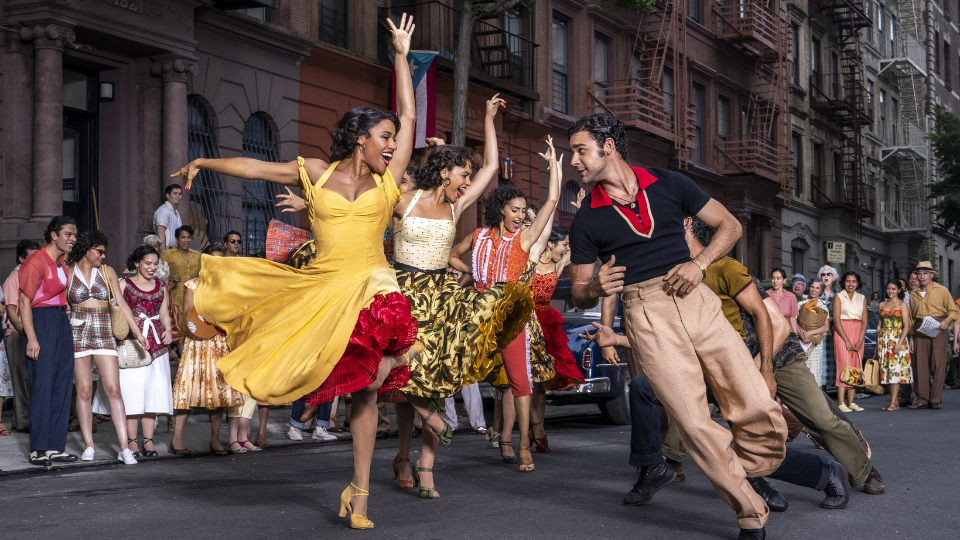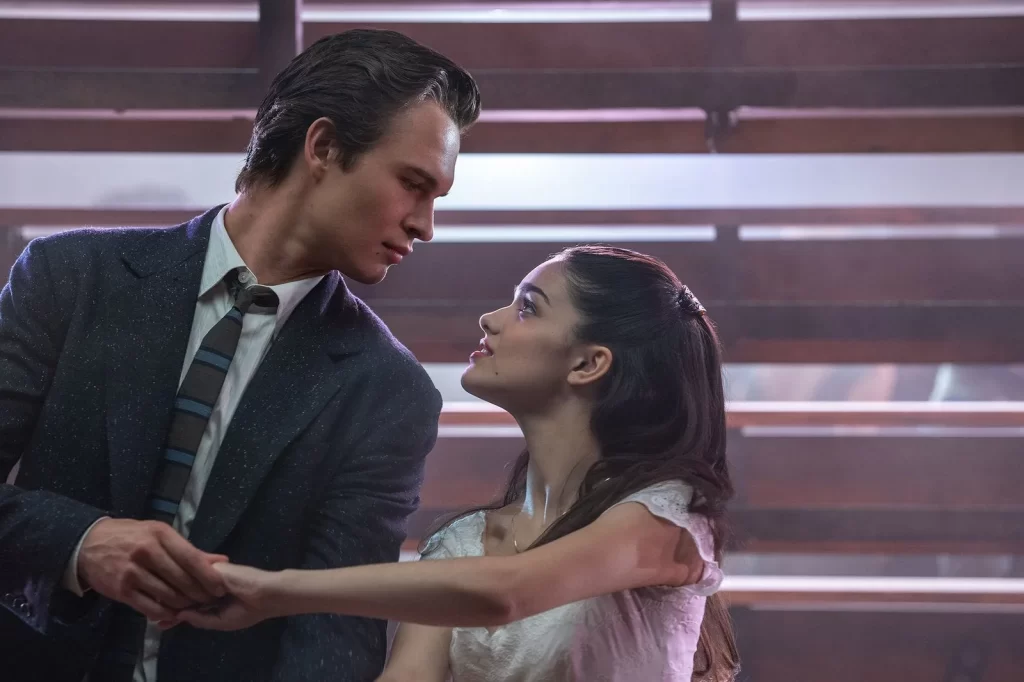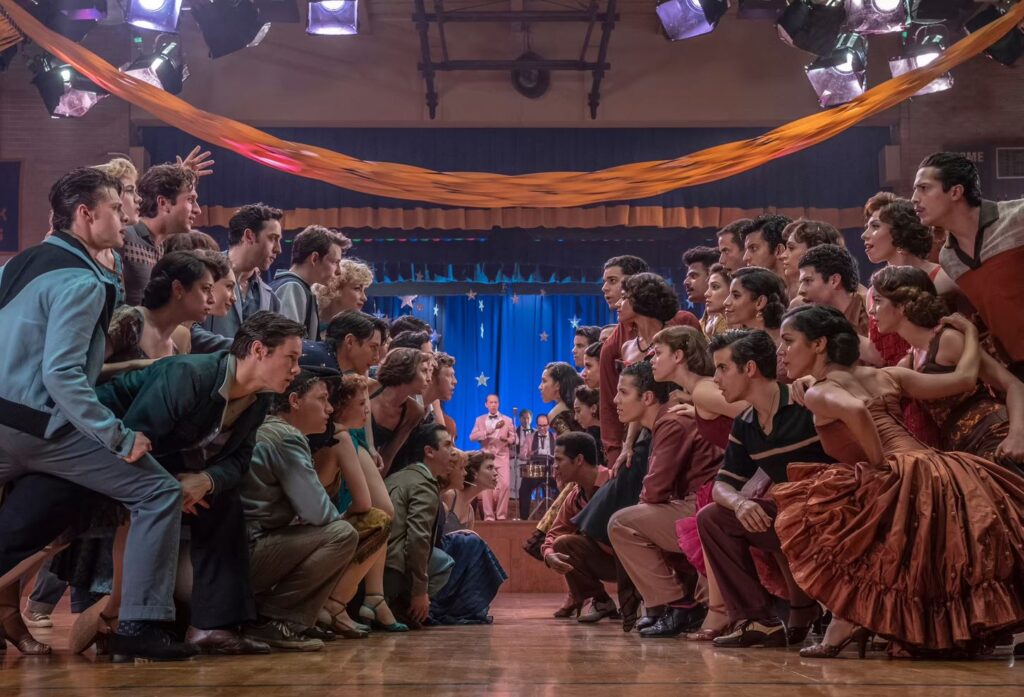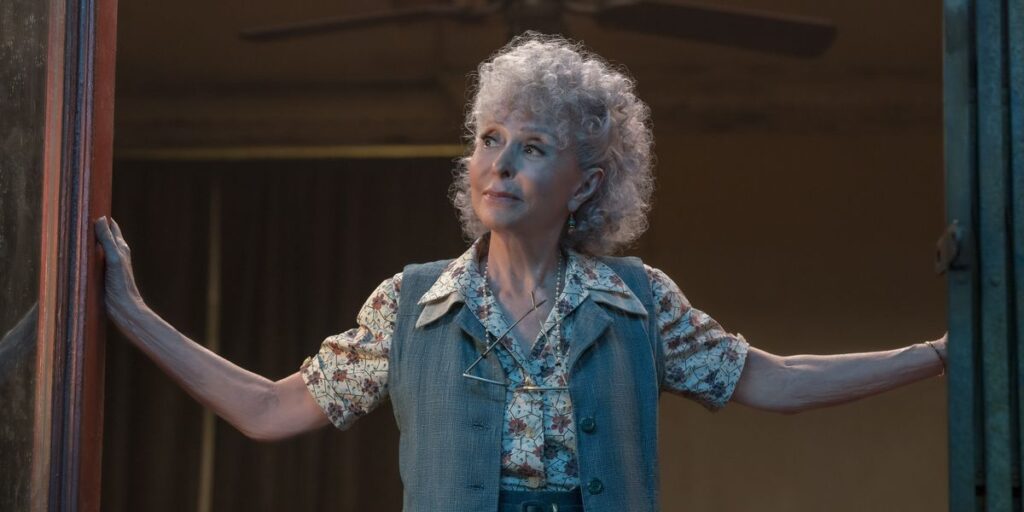
Is West Side Story Steven Spielberg’s first musical, or his 30th? For nearly half a century, one of cinema’s greatest directors has been concocting robust sequences that bear the indicia of musical numbers: nimble choreography, balletic grace, syncopated rhythm. To survey his most impressive achievements—the vigorous chases of Raiders of the Lost Ark, the rampaging dinosaurs of Jurassic Park, the futuristic mayhem of Minority Report, and countless more—is to witness the work of a filmmaker who applies his craft with the precision of an inveterate composer. In essence, Spielberg has been making musicals for 50 years; West Side Story is just the first one that happens to include songs.
One of the ironies of his new feature is that those songs are virtually the opposite of original creations. Instead, viewers with even a cursory knowledge of Broadway hits will instantly recognize the soaring melodies of Leonard Bernstein and the snappy lyrics of Stephen Sondheim, which (as if you need me to tell you) were repurposed six decades ago by Robert Wise and Jerome Robbins into an Oscar-sweeping smash. This familiarity necessarily dilutes the frisson of anticipation that attends any new Spielberg picture—how can Hollywood’s preeminent dazzler dazzle us when we’ve already been dazzled?—yet it also makes a certain sense. Spielberg’s virtuosity as a director lies not in his talent for pure invention (he hardly ever writes his own scripts), but in his gift for wielding the traditional elements of cinematic action—running, jumping, driving, dancing—in exhilarating new ways.

And his West Side Story is a triumph—a bold and sumptuous feat of aesthetic execution and artistic imagination. It is the work of a shameless but undeniable showman (he’s a vet, and a vet all the way), a quality that he cleverly extends to his cast. Consider the film’s riveting opening number, which finds a group of Manhattan toughs wordlessly assembling (they seem to communicate through whistles) before venturing into enemy territory. These are the Jets, their Puerto Rican rivals are the Sharks, and you already knew that. What you didn’t know—or, rather, what you haven’t yet seen—is the preening vitality of their movements, the way they literally dance through the streets with swaggering arrogance. This is not, strictly speaking, how gang members behave, but the heightened (un)reality of the musical is in keeping for a director who invariably jettisons authenticity in favor of awe. (Real life does playfully intrude for a moment when the Jets pause at a crosswalk to allow innocents to pass by unmolested.) The characters’ persistent peacocking is a perfect fit for a craftsman who is unabashedly strutting his stuff.
This isn’t to suggest that West Side Story is frivolous. The screenplay, by Tony Kushner (adapting the stage book by Arthur Laurents), directly tackles topics of contemporary resonance: immigration, assimilation, gentrification, bigotry. The politics of the original play, with its Romeo and Juliet inspirations, have always been somewhat simplistic, with a crude “Can’t we all just get along?” slant. Kushner, as he must, retains the broad focus on dueling factions, but he sprinkles in kernels of ambiguity, blurring heroes and villains into slightly more complex figures of anger and discontent. “I wake up to everything I know either getting sold or wrecked or being taken over by people that I don’t like,” says Riff (an electric Mike Faist), the leader of the Jets. That kind of replacement-theory rhetoric might appeal to the Proud Boys, but Riff is a loyal friend and a savvy negotiator as well as a thug, and the movie treats him as both instigator and sufferer. His counterpart with the Sharks, Bernardo (David Alvarez, very fine), is stereotypically hotheaded but also a caring lover and protective older sibling, plus a sharp student of race relations; when his girlfriend Anita (Ariana DeBose) declares that life is alright in America, his retort—“If you’re all-white in America”—arguably carries greater potency than it did 60 years ago. (Meanwhile, the character of Anybodys, played by the non-binary actor Iris Menas, is now explicitly trans.) Much of the dialogue between Bernardo, Anita, and the rest of the Sharks takes place in unsubtitled Spanish, a risky choice that nonetheless contributes to the film’s sense of local flavor and intimacy.

Together, Spielberg and Kushner efficiently delineate a neighborhood that seethes with bluster and tension, a powder keg that begins to ignite when a certain pair of star-crossed lovers make moony eyes at one another across a dance hall. These, of course, are Riff’s friend Tony (Ansel Elgort) and Bernardo’s younger sister María (newcomer Rachel Zegler), and their inevitable romance is simultaneously the movie’s weak link and its source of power. The issue isn’t so much that the stars lack chemistry as that their characters’ relationship is so plainly a product of the plot’s machinery; an invisible hand seems to steer them into one another’s arms and hearts, only for them to be cruelly ripped apart. This is, to be sure, how classical tragedies work, but there’s still something engineered about their zero-to-sixty ardor; despite the sweetness of their meet-cute (“You’re tall.” “You’re not.”), their passion receives little room to breathe.
Yet even if it’s contrived in miniature, Tony and María’s abject besottedness synchronizes with the film’s overall heedlessness, echoing its grander Shakespearean design. An undercurrent of sincere longing runs through the picture, one that the actors ably punch up. Elgort, who seems to have dodged allegations of sexual assault, isn’t the prototypical matinee idol, but he’s a big guy who’s rarely looked so large on screen; he tends to loom over his costar, a size disparity he subverts with his softly rounded singing voice and soulful sensitivity. (In the duet “Tonight”, Spielberg slyly reverses the dynamic, having Elgort stare upward at Zegler through a fire escape grate.) For her part, Zegler beautifully conveys the sheer giddiness of young love, whether she’s floating through a department store chirping “I Feel Pretty” or rollicking amid her untainted bedsheets. The tenderness of the leads contrasts nicely with the more vigorous turns from the supporting cast, in particular Faist, who lends Riff a mixture of cocksure bravado and wounded insecurity; when he wipes sweat from his brow following a particularly tense confrontation, it adds meaning to the lyric, “Little boy, you’re a man/Little man, you’re a king.”

The real king, though, is Spielberg. The numbers he conceives in West Side Story are more than just boisterous sing-along hymns. They are expertly calibrated productions, marvels of movement, color, and rhythm. Working with the choreographer Justin Peck (who previously contributed to, of all things, Red Sparrow), Spielberg exploits the medium’s inherent musicality, the way image and sound can combine into magic. The obvious highlights are the dance at the gym, which finds Janusz Kaminski’s camera hovering above and gliding through pirouetting attendees like a nosy chaperone, and “America”, which accentuates Anita and Bernardo’s cheeky back-and-forth (“Everyone there will give big cheer!” “Everyone there will have moved here.”) with spry leaping and crisp editing. But virtually all of the numbers are informed by an impish streak of innovation: the way a woman sprays glass cleaner on a mirror in perfect time with the staccato blasts of brass on “I Feel Pretty”; the way the slapstick posturing of “Gee, Officer Krupke” becomes an anthem of assertion; the way the silvery “Cool” turns boyish puffery into genuine menace. By the time we reach the climactic rumble—which is introduced with a gorgeous overhead shot of the two gangs cautiously approaching one another, glimpsed only in silhouette—the process of immersion is complete, and Spielberg has somehow transposed his own gifts; where previously he was an action director adapting his talents to songcraft, suddenly he’s a maestro harnessing his musical skills in the service of action, delivering a knife fight that’s basically a song without words.
Curiously enough, it’s during the gentler ballads (in particular “Something’s Coming” and “María”)—when Spielberg curbs his visual audacity and lets the music itself sing—that the scent of replication begins to creep in, and our foreknowledge of the lyrics intrudes on the movie’s mystery. Even here, though, he provides images of surpassing loveliness, such as a crane view of Tony balancing on a railing during “Tonight”, or a two-shot of María and Tony touching their foreheads together during “One Hand, One Heart” as golden sunlight streaks in through a faraway window. (The colors are exquisite throughout, from the bright pastels of the fabrics draping Anita’s apartment to the blood-red belt María fastens to her virgin-white dress, a striking accessory that she matches with a defiant slash of red lipstick.) And there is no denying the emotional might of “Somewhere,” performed by a wonderful, sorrowful Rita Moreno, whose role as Tony’s watchful benefactor links Spielberg’s version with the original in the best of ways.

Speaking of that link, the question which automatically accompanies any remake—much less one of a cherished, Best Picture-winning classic—is that of necessity: Did this movie need to be (re)made? It’s an understandable impulse, albeit a self-defeating one; no individual movie needs to be made, even if the movies themselves are essential to the fabric of modern life. Still, it’s fair to ask why Spielberg chose to revive an already-beloved property rather than cast his genius elsewhere.
He answers this question with a brilliant blend of piety and rebellion. In reimagining West Side Story, Spielberg pays tribute to the 1961 version while also demonstrating the value of change, both in art and in the world. I intentionally declined to rewatch the original in advance of seeing the update (what fresh eyes I had!), but no level of familiarity can mitigate the sweeping, propulsive energy of this new enterprise. Spielberg’s argument, which he makes with vividness and force, is that art is dynamic rather than static. We’ve seen this story before, but we’ve never seen it like this, and in investing West Side Story with renewed vitality, he also mounts a broader defense of cinema as a medium: that the movies, with all their power and wonder, remain a place for us.
Grade: A-
Jeremy Beck is the editor-in-chief of MovieManifesto. He watches more movies and television than he probably should.
